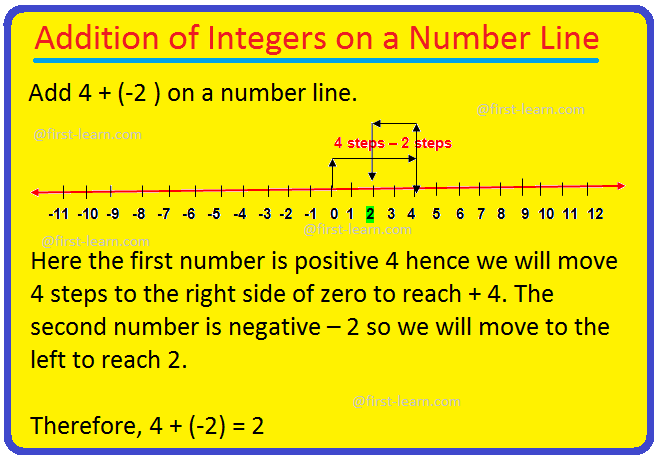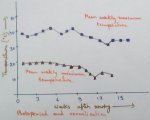Addition of Integers on a Number Line
After learning representation of integers on a number line now we will learn addition of integers on a number line. For the purpose of learning addition of integers on a number line we have to keep certain points things in mind.
- We know that positive numbers are on the right side of zero. Hence while adding positive numbers we will move to the right side of number line.
- We know that negative numbers are on the left side of zero. Hence while adding negative numbers we will move to the left side of number line.
Now we need to follow certain steps for adding integers on number line.
- First we have to draw a number line
- Then mark the integers on the number line
- Then mark the first number of the addend on the number line
- Then mark the second number of the addend on the number line
Now if the second addend is positive we will move to the right side of the number line
If the second addend is negative then we will move to the left side of the number line
Here are few examples to show to addition of integers on a number line.
1. Add 3
and 2 on a number line.
Solution:
The first number is 3 (positive) so we moved 3 steps to the right of zero to reach 3 and then the second number is also positive so we moved two more steps to the right again to reach 5.
Therefore, 3 + 2 = 5
2. Add (-2 ) + (-2 ) on a number line.
Solution:
The first number is negative that is -2 so we mover 2 steps to the left side of zero to reach -2. Then the second number is also negative that is -2 so we will again move two steps to the left of zero to reach at -4.
Therefore, (-2 ) + (-2 ) = - 4
3. Add 4 + (-2 ) on a number line.
Solution:
Here the first number is positive 4 hence we will move 4 steps to the right side of zero to reach + 4. The second number is negative – 2 so we will move to the left to reach 2.
Therefore, 4 + (-2) = 2
4. Add (- 4) + 3 on a number line.
Solution:
Here the first number is -4 so we have to move 4 places to the left side of zero to reach – 4. The second number is + 3 so we have to move three steps to the right -4 to reach -1.
Therefore, (- 4) + 3 = -1
From Addition of Integers on a Number Line to HOME PAGE
Recent Articles
-
Eleventh Grade | Eleventh Grade Science | Eleventh Grade Math
Jun 27, 25 12:26 AM
Eleventh grade biology has been designed in accordance with the recommended topics. We will cover all the topics in biology very exciting and interesting way. -
Explain Digestion of Food | Salivary Glands | Oesophagus | Stomach
Jun 27, 25 12:20 AM
Before the digestion is start by the different enzymes secreted from the different digestive glands food must be turned and chut or mixed with saliva inside the mouth. -
Explain Human Digestive System | Mouth | Tongue | Pharynx | Teeth
Jun 21, 25 01:15 PM
Digestive system is a system of alimentary canal and digestive glands. Alimentary canal- alimentary canal is a tube of variable diameter having muscular wall and glandular epithelial tissues which sta… -
Vernalisation in Plants | Definition | Mechanism | Devernalization |
Jun 18, 25 01:34 PM
Definition of vernalisation- The change of flowering habit due to the low temperature treatment is known as vernalisation. This is a physiological process which was denoted by Clipart in 1857 invite b… -
The Food We Eat | Food we Get from Plants and Animals | Carbohydrates
Jun 15, 25 03:20 PM
What are the food that we should eat? Find out the names of ten food items in the word maze. Write the names in the correct column of the table given below. Food we get from plants Food we get from an…










New! Comments
Have your say about what you just read! Leave me a comment in the box below.